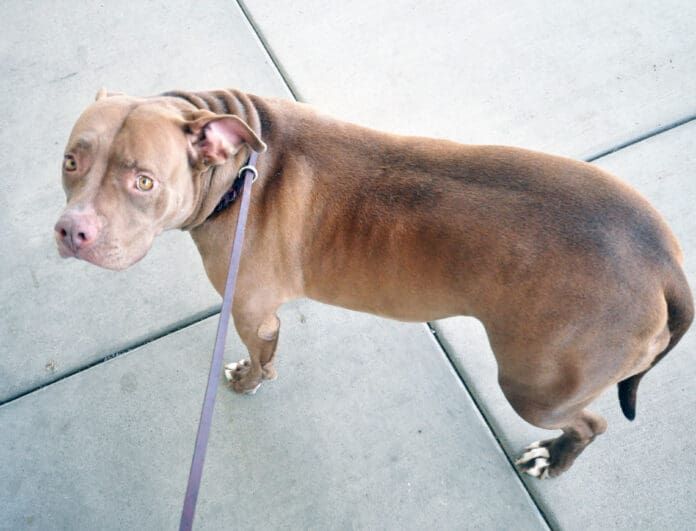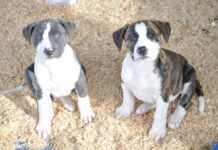A professional organization called the Association for Pet Obesity’s Prevention (APOP) recently released a report stating that most of the dogs in the U.S. are overweight, their owners don’t know it, and their veterinarians don’t feel comfortable talking to their clients about it. This feels like crazyland to me!
I think I have to agree with the premise that most people really don’t recognize their dogs’ weight problem. When I attempt to have conversations with the owners of fat larger breed dogs, nine times out of 10, the owner will say, “Well, his mother and father both weighed over 100 pounds, these are just a large breed!” Or, “He’s in the weight range for the breed standard!” Ignoring the fact that the dog has no waist whatsoever and is literally covered with fat rolls.
Small dog owners often just think their dogs are cute. And as long as they can pick them up, they don’t think the weight is a problem.
My own sister didn’t get serious about reducing the weight of her little dogs until Dinah, a presumed Chihuahua/Dachshund-mix, got so obese that she couldn’t maintain the hygiene of her own nether end and developed serious anal gland issues. WARNING: This is exceedingly gross to contemplate. Skip the next paragraph if you are easily grossed out!
When lick their own butts, it helps keep the anal glands in working order. Big dogs have fewer problems with their glands than small dogs partly because they have bigger, stronger tongues, which help massage and empty the glands when they lick their butts. When dogs like Dinah get too fat to reach their bottoms with their tongues, the glands can become impacted and infected unless the owner is aware of this and makes sure to either empty the glands or take the dog to a groomer or vet occasional to have the glands checked and emptied.
Anyway, to me, the most shocking part of the report is the allegation that 84% of the veterinarians who responded to the survey said they don’t want to upset their clients by talking about their dogs’ weight. But health and weight are so linked in dogs! I think that if a vet fails to discuss a dog’s overweight it’s a total dereliction of their veterinary duty! The problems associated with or directly caused by obesity in dogs are legion!
And yet, I get it. A vet only gets so much time with a client, and it probably often feels like there isn’t enough time to talk about the dog’s more pressing health issues and the overweight condition—even if the obesity may have contributed to the problem. Even at well-pet visits, people often spend more time discussing flea and heartworm preventives, vaccines, and the like.
My friend Tim Steele, a gifted dog trainer (who broke my heart by moving from my area to Florida a couple years ago), once told me that he never talks directly to dog owners about their dogs’ weight problems; he addresses his concerns to the dog—in front of the owner, obviously! He’ll say, “Oh my goodness, who is measuring your food? Or are you sneaking into the refrigerator at night?! I think you need to get on a little diet!” Often, he reports, the owner will join the “conversation” at that point, saying something like, “Do you really think he needs to be on a diet?” instead of feeling directly confronted. I think that’s a genius approach—and perhaps one I can recommend to veterinarians!
My appreciation to reporter Tim Wall of Petfood Industry for being the first to cover the APOP’s 2023 survey.







Thank you for this information. It is very sad to see so many dogs not live their best life because honors over feed.
Thanks for the article. I am guilty of feeding my dog too much. My vet did tell me about how they are getting too large and provide a website to assist. I was not offended with what my vet said; rather very thankful.
I do measure my dog’s food and we weigh them every 2 weeks (and track their progress). They do not get table scraps or treats. We get the minimum 2 hours of exercise a day between walks and playtime. Yet they are still on the fat side.
I must say that a lot of the top brand dog foods don’t make it easy for owners to keep dogs trim. I spend a lot of time reading dog food labels to find one that will meet the 350 kcal daily requirement my vet recommended for my dog. I find most dry dog foods are well over 400kcal/cup and lots of fat, especially the grain free varieties. When I look at various brands, the feeding recommendations are not consistent. Some have me feed my dogs well over 500 kcal/day. I know they are ‘recommendations’, but seriously how could they be so far off the calorimetric needs of a dog? Human foods are much easier to portion than dog food. Currently, I find the dog food that works for mine is ‘fat dog’ by Natural Balance. At least they feel full at the end of their meals. Anyone else find a low-calorie dog food that works for them?
It would be helpful if dog food bowls were sized appropriately for small dogs. Even glass cat food bowls are too large. Years ago I found mini Pyrex tart plates (now discontinued) which are the perfect size.
This, of course, is to control me and serving size.
I’ve started making dog food but for Diana (82lb) and Freyja (48 lb) it is becoming cost prohibitive. I have to make a batch every five days and costs me about $10 a day. I don’t even eat that much.
I do find that silicon SuperCubes on amazon are great for portioning food. I use one cup and half cup trays. I calculated how many calories they need per day, then used a calculator to analyze all of the ingredients I use and give me a calories per cup of food. They’ve been doing great but I am going to have to move to half home made and half kibble just to save on the cost. Kibble only is about $3.30 a day so the home made, while healthy is also three times the cost.